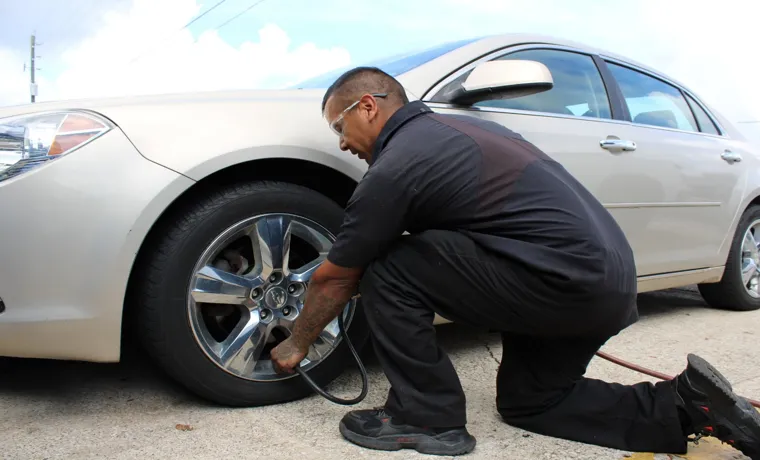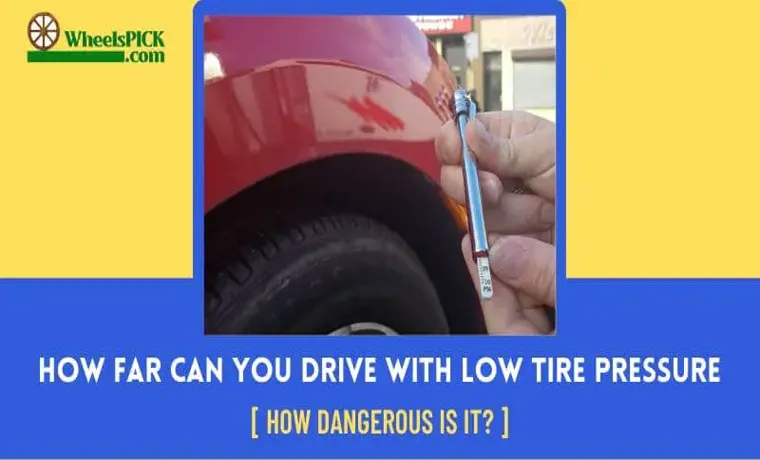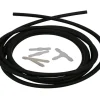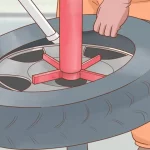Driving with low tire pressure can be a concerning experience, especially if you’re unsure of just how far you can travel without causing additional damage or jeopardizing your safety. While it’s never a good idea to keep driving with a flat tire, low tire pressure can be a different story altogether. Understanding just how far you can drive with low tire pressure can be the key to avoiding stress and staying safe on the road.
In this blog, we’ll take a look at how driving with low tire pressure can impact your vehicle, what causes low pressure, and most importantly, how far you can expect to travel when you notice that your tires are running low on air. So, buckle up and let’s dive into the world of low tire pressure!
Table of Contents
Understanding Low Tire Pressure
If you’re wondering how far you can drive with low tire pressure, the answer really depends on how low the pressure is. Generally, driving with low tire pressure is not recommended as it can lead to a variety of issues, including reduced fuel efficiency, uneven tread wear, and potential safety concerns. It’s important to regularly check your tire pressure and ensure they are inflated to the manufacturer’s recommendation.
If you do notice low tire pressure while driving, it’s best to pull over and address the issue immediately. Continuing to drive on low tire pressure can cause further damage to your tires and potentially even lead to a blowout. Remember to prioritize the safety of yourself and others on the road by keeping your tires properly inflated.
What Causes Low Tire Pressure?
Low tire pressure can occur due to several reasons, and it has become a frequent problem for many car owners. One of the major causes is a puncture or damage to the tire, which can cause air to leak out slowly. Another common cause is a change in temperature, which can cause the air inside the tire to contract and reduce the tire pressure.
Moreover, tire sidewall damage, valve stem damage, and wheel damage can also result in low tire pressure. It is essential to maintain the correct tire pressure to ensure safe and efficient driving. To avoid low tire pressure, always keep an eye on the tire pressure level, and ensure that you check the pressure regularly, ideally every month.
By doing so, you can help extend the life of your tires and ensure your driving safety.

How to Check Tire Pressure
Low tire pressure is a common problem that many car owners face. It can lead to decreased fuel efficiency, reduced handling, and even tire failure in extreme cases. That’s why it’s important to regularly check your tire pressure and make sure it’s at the recommended level.
To do this, you’ll need a tire pressure gauge, which is an inexpensive tool you can find at any auto parts store. Simply remove the valve cap from your tire, place the gauge onto the valve stem, and press down firmly. The gauge will give you a reading in pounds per square inch (psi).
If the pressure is too low, use an air compressor to inflate the tire to the recommended level, which can be found in your car’s manual or on a sticker inside the driver’s side door. By keeping your tires properly inflated, you’ll not only save money on gas, but you’ll also ensure a safer and more comfortable driving experience.
The Effects of Driving with Low Tire Pressure
Many drivers wonder how far they can drive with low tire pressure before causing damage or putting themselves and others at risk. The answer varies depending on several factors, including the severity of the pressure loss and the type of driving conditions. Generally, driving with low tire pressure can have several negative effects, including reduced fuel efficiency, decreased steering and handling ability, and increased risk of tire blowouts or accidents.
It is important to check your tire pressure regularly and inflate them to the correct level to prevent these issues and ensure safe and efficient driving. Keep in mind that the recommended tire pressure can vary depending on the vehicle make and model, so consult your owner’s manual or a professional mechanic for guidance. By maintaining proper tire pressure, you can not only prolong the life of your tires but also ensure your safety on the road.
Reduced Fuel Efficiency
Low tire pressure can have a significant impact on your vehicle’s fuel efficiency. When your tires are underinflated, it causes increased friction between the tires and the road, resulting in a decrease in fuel efficiency. The engine has to work harder to maintain the same speed, which in turn uses more fuel.
According to some statistics, low tire pressure can decrease fuel efficiency by up to 3%. This may not seem like a lot, but over time, it can add up and cost you money in fuel expenses unnecessarily. Not only that, but it also increases wear and tear on your tires and can lead to costly replacements down the road.
It’s important to check your tire pressure regularly and keep them inflated to the manufacturer’s recommended levels. By doing so, you can ensure that you’re getting the best fuel efficiency possible while also prolonging the life of your tires. So, next time you hit the road, make sure your tire pressure is at the right level, and you’ll be saving yourself some money in fuel expenses!
Increased Risk of Accidents
Driving with low tire pressure can increase the risk of accidents on the road for several reasons. When a tire is underinflated, it can become flatter and wider, which can lead to increased friction with the road surface. This can cause the tire to overheat and eventually fail, leading to a blowout or loss of control.
Additionally, low tire pressure can affect the handling and braking of a vehicle, making it more difficult to maneuver in sudden or emergency situations. Even a small drop in tire pressure can have a significant impact on a vehicle’s safety and performance. It is important to regularly check your tire pressure and maintain the recommended levels for your vehicle to ensure that you are driving safely on the road.
Remember, your car’s tires are the only point of contact between your vehicle and the road, making them a vital component for safe driving.
Tire Damage
Driving with low tire pressure is never recommended as it can lead to severe tire damage, compromising your safety on the road. When your tires are underinflated, they are more likely to wear out quickly, resulting in a shorter lifespan. Additionally, low tire pressure can make your vehicle unstable and harder to control, leading to an increased risk of accidents.
Moreover, driving on underinflated tires can cause overheating, tire separation, and even tire blowouts, which are dangerous and potentially life-threatening. Therefore, it is essential to regularly check and maintain your tire pressure to ensure your safety and prolong the life of your tires. Remember, a few minutes of maintenance can save you from costly and hazardous consequences on the road.
Factors That Affect How Far You Can Drive with Low Tire Pressure
If you’re wondering how far you can drive with low tire pressure, the answer varies depending on several factors. The most critical factor is the degree of underinflation. For instance, driving with just 25% lower-than-normal tire pressure could reduce the tire’s tread life by half.
Moreover, tires that are just ten lbs per square inch (PSI) underinflated can lower fuel economy by as much as five percent. The type of tire and vehicle you’re driving also come into play since different tires, sizes and weights will experience different consequences from underinflation. Other factors include speed, driving conditions, and the load the tire is supporting.
Generally, it’s recommended that you avoid driving for too long with a tire that’s underinflated; if your TPMS warning light comes on, it’s best to get the tire inflated or repaired right away. In case you’re travelling on a spare tire, bear in mind that the spare is meant to be a temporary solution for you to drive to a repair shop to get the real tire fixed. Overall, driving with low tire pressure could be unsafe and lead to more significant complications down the road, so it’s always best to take care of things promptly.
Type of Tire
When it comes to how far you can drive with low tire pressure, the type of tire you have on your vehicle is a major factor to consider. Different types of tires have varying inflation levels and capacities, which can affect how long you can go without needing to refill or change your tire. For example, all-season tires have a wider range of inflation levels compared to winter or summer tires.
This means that they can handle a greater variance in pressure before they reach critical levels. Additionally, tires with a high load capacity can usually support more weight, which can help compensate for the impact of low pressure on their performance. However, it’s important to note that just because you have a specific type of tire does not mean that you can completely neglect your tire pressure maintenance.
Regularly checking and adjusting your tire pressure to the recommended level for your tire type is always the best way to ensure optimal vehicle performance and safety on the road.
Weight of the Vehicle
When it comes to having low tire pressure, there are a number of factors that can affect how far you can drive before encountering serious problems. One major factor is the weight of your vehicle. The heavier your vehicle is, the more strain will be placed on your tires, especially when they’re already underinflated.
This means that larger SUVs, trucks, and vans will be at a higher risk of damage and reduced fuel efficiency. Another factor to consider is the type of tires you have. Some tires are simply better equipped to handle low pressure, and may be able to maintain their performance for longer without any serious problems.
Ultimately, it is always best to err on the side of caution and take immediate steps to address any tire pressure issues to ensure your safety on the road.
Driving Conditions
Driving with low tire pressure is never a good idea. It not only increases the risk of a tire blowout but also significantly affects your vehicle’s fuel efficiency. However, if you find yourself in a situation where you must drive with low tire pressure, there are several factors that may affect how far you can drive.
The first factor is the speed at which you’re driving. The faster you drive, the quicker the tires heat up and expand, increasing the risk of a blowout. The second factor is the weight of your vehicle and the load it’s carrying.
Overloading your vehicle weight will also affect the tire’s ability to hold air. The third factor is the type and condition of the road you’re driving on. Driving on rough, uneven terrain can cause extra stress on the tires, leading to a potential blowout.
Lastly, the outside temperature can also affect tire pressure. In colder temperatures, tires tend to lose pressure, whereas in hot temperatures, they may be overinflated. If you do need to drive with low tire pressure, make sure it’s only for a short distance, and make sure to keep your speed low, avoid overloading the vehicle, and stay on smooth roads whenever possible.
Remember, safety should always come first.
How Far Can You Drive with Low Tire Pressure?
Driving on low tire pressure can be risky and even dangerous. It’s important to check your tire pressure often, especially before going on long trips. The general rule of thumb is that you can drive on low tire pressure for no more than 50 miles.
However, this can vary depending on factors such as the type of tire, the weight of the vehicle, and the severity of the pressure drop. Driving on low tire pressure for too long can result in a blowout, which is not only dangerous but also expensive to repair. Additionally, driving on underinflated tires can cause uneven tire wear and decrease fuel efficiency.
To avoid these problems, it’s best to always have your tires properly inflated and to check them regularly to ensure they are in good condition.
Using Tire Pressure Monitoring Systems
Tire Pressure Monitoring Systems Getting a flat tire is never fun and it’s even worse if you’re not aware that the tire is losing air. That’s where tire pressure monitoring systems (TPMS) come in handy as they alert drivers when their tire pressure drops below a certain level. But how far can you drive with low tire pressure? The answer depends on several factors, such as how low the pressure is, the weight of the vehicle, and the speed at which you’re driving.
Generally, it’s recommended to not drive more than a few miles with low tire pressure as it can cause the sidewalls of the tire to flex excessively, leading to permanent damage. It’s also important to note that driving with low tire pressure can lower your fuel efficiency and increase the risk of a blowout while driving. So, if your TPMS warns you about low tire pressure, it’s best to stop at the nearest gas station or auto body shop and inflate your tires to the recommended pressure level.
It’s a little inconvenience for a lot of safety.
Using the Penny Test
Have you ever wondered how far you can drive with low tire pressure? The answer may surprise you. In fact, driving with underinflated tires can cause a number of problems, including reduced fuel efficiency, increased tire wear, and even the risk of a blowout. So how can you tell if your tires are properly inflated? One easy way is to use the penny test.
Simply insert a penny into the tread of your tire, with Lincoln’s head facing down. If you can see all of Lincoln’s head, your treads are too shallow, and it’s time to replace your tires. If some of Lincoln’s head is covered by the tread, your tires are likely in good shape.
Keep in mind that tire pressure should be checked regularly, especially before long trips. By keeping your tires properly inflated, you can extend their lifespan and stay safer on the road.
Consulting a Mechanic
If you notice that your tire pressure is low, it’s essential to seek the advice of a mechanic before driving. Low tire pressure can cause serious problems, including flat tires, blowouts, and reduced fuel economy. The exact distance you can drive with low tire pressure varies depending on the situation.
If you’re traveling at high speeds or on rough terrain, your tires will experience more stress, and the risk of damage increases. Additionally, some vehicles have tire pressure monitoring systems that will alert you when there’s an issue. If you drive with low tire pressure for too long, you’ll be compromising your vehicle’s safety and potentially causing costly damage to other parts of your car.
Always consult a mechanic if you have any doubts about your tire pressure, and never take unnecessary risks on the road.
Conclusion
In the end, the question of how far you can drive on low tire pressure depends on a number of factors – the type of tire, the severity of the pressure drop, and the conditions of the road. However, rather than testing the limits, it’s always best to take the responsible route and address the issue as soon as possible. After all, the only thing that’s flat-out fun about driving on a flat is the puns.
“
FAQs
What Are the Risks of Driving with Low Tire Pressure?
Driving with low tire pressure can cause decreased fuel efficiency, increased risk of blowouts, and longer braking distances.
How Can I Tell If My Tire Pressure Is Low?
You can use a tire pressure gauge to check the pressure, or some vehicles have a sensor that will alert you if the pressure is low.
What Should I Do If My Tire Pressure Is Low?
You should fill your tires to the recommended pressure as soon as possible. If you can’t do it yourself, take your vehicle to a mechanic or service station.
Can I Drive on a Flat Tire?
No, driving on a flat tire can cause irreparable damage to the tire, rim, and even the vehicle. It can also be dangerous and cause loss of control of the vehicle.
What Is the Recommended Tire Pressure for My Vehicle?
The recommended tire pressure can usually be found in your vehicle owner’s manual or on a sticker on the driver’s side door jamb.
Will Low Tire Pressure Affect My Vehicle’s Handling?
Yes, low tire pressure can cause the vehicle to handle differently, making it more difficult to control. It can also cause a loss of traction and make it more difficult to stop.
How Often Should I Check My Tire Pressure?
You should check your tire pressure at least once a month, or before any long road trips. Regular tire maintenance can help prolong the life of your tires and save you money in the long run.




